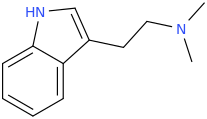A very interesting 2-AT is MDAT, the methylene ether derivative of 6,7-ADTN. From the Wikipedia aricle:
6,7-Methylenedioxy-2-aminotetralin (MDAT) is a drug developed in the 1990s by a team at Purdue University led by David E. Nichols.[1] It appears to act as a serotonin releasing agent based on rodent drug discrimination assays comparing it to MDMA, in which it fully substitutes for, and additionally lacks any kind of serotonergic neurotoxicity.[1] Hence, MDAT is considered likely to be a non-neurotoxic, putative entactogen in humans.
https://en.wikipedia.org/wiki/Empathogen–entactogen

I found nothing on the stereochemistry of the amine group. & I don't have access to the J Med Chem article where it was made & tested. Has this ever been encountered as a RC?
6,7-Methylenedioxy-2-aminotetralin (MDAT) is a drug developed in the 1990s by a team at Purdue University led by David E. Nichols.[1] It appears to act as a serotonin releasing agent based on rodent drug discrimination assays comparing it to MDMA, in which it fully substitutes for, and additionally lacks any kind of serotonergic neurotoxicity.[1] Hence, MDAT is considered likely to be a non-neurotoxic, putative entactogen in humans.
https://en.wikipedia.org/wiki/Empathogen–entactogen

I found nothing on the stereochemistry of the amine group. & I don't have access to the J Med Chem article where it was made & tested. Has this ever been encountered as a RC?



